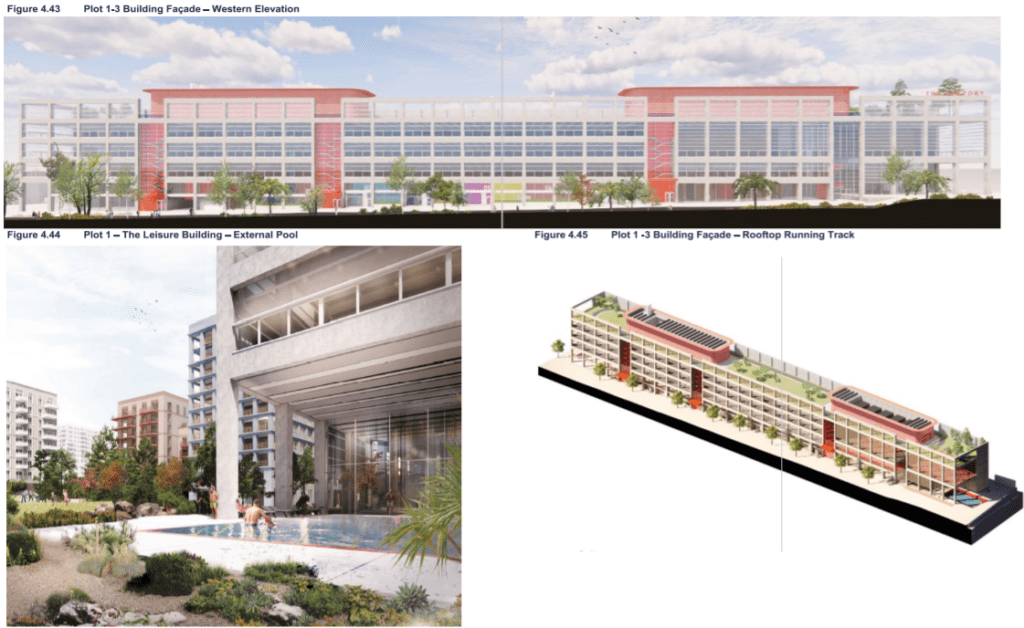Planning officers at the Greater London Authority (GLA) have issued guidance to their counterparts at the London Borough of Newham to refuse planning consent to developer Ballymore for a residential lead scheme on the Thames Road industrial estate in Silvertown.
In a document published on Monday 14th November, the officers at the soon to be vacated City Hall in London Bridge have set out four reasons for refusal for the scheme designed by Glenn Howells Architects and HAL Architects.
Land Use Principles
Whilst the London Plan promotes the optimisation of land, particularly through the development of brownfield land as a leading way of delivering new homes, particularly given that the site is within the Royal Docks and Beckton Riverside Opportunity Area which sets out development capacity of 30,000 homes and 41,500 new jobs.
However, this scheme will result in the loss of a waste recycling facility that has an environment agency permit, the site is therefore regarded as a safeguarded waste site with a waste throughput of 29,505 tonnes in 2019. Whilst London plan policy makes it clear that existing land uses should be safeguarded or result in no net loss resulting in its redevelopment.
Whilst the applicant Ballymore is committed to finding a new site for the facility and a planning obligation is proposed to secure a relocation strategy. Such a plan is yet to be put in place and therefore the application as it was submitted to the East London council will result in a net loss of waste processing throughout capacity.

Affordable Housing
There is a requirement of 50% affordable housing on industrial land that is suitable for residential lead development for first-time redevelopment. In this instance, Policy H2 of the borough’s Local Plan sets a strategic target of 50% and expects schemes with 10 or more units to deliver between 35% and 50% affordable housing, with a tenure mix of 60% social housing and 40% intermediate homes.
Ballymore has only proposed only 17.4% affordable housing by habitable room, comprised of 60% social rent and 40% shared ownership, is proposed across both phases for phase 1, 11% is proposed. Whilst the tenure split is supported, the amount of affordable housing proposed falls well short of expectations on this site.
This is despite the requirement being clear for a number of years and the delivery of policy-compliant levels of affordable housing must be embedded within land transactions and in proposals’ design from the outset as well as providing a draft S106 agreement for the settlement in regards to social rent homes and those available under Shared Ownership.
Transport
In line with Policy T2 and Policy T4 of the London Plan, working with the Council, appropriate mitigatory measures should be secured with any permission. Various traffic calming measures within the development is proposed, which support the Mayor’s Healthy Streets approach.
However if approved a car-dominated landscape would still result due to the level of car parking proposed, contrary to Policy T2. This is particularly prevalent on and around the riverside walk creating an unattractive environment along with a key walking and cycling connection. In principle, the proposals for improvements to Thames Road to support active travel are welcomed and in line with the Healthy Streets approach.
Due to the currently poor pedestrian and cyclist environment, in line with Policy T4 of the London Plan, a contribution towards the delivery of the North Woolwich scheme and the securing of improvements to Thames Road through an s278 agreement are required to mitigate the impact of the development.

Sustainable development and environmental issues
Whilst the scheme does propose various measures at traffic calming, which support the Mayor’s Healthy Streets approach. However, despite this, the scheme still has a relatively car-dominated landscape that would still result due to the amount of car parking proposed contrary to Policy T2 of the Mayor’s local plan. This is particularly prevalent in and around the riverside walk creating an unattractive environment along with a key walking and cycling connection. Revisions are required to make the area more appealing and secure for pedestrians and cyclists.
Whilst the development would provide 2,759 residential long-stay cycle parking spaces and 177 long-stay commercial spaces as well as 201 short-stay spaces for both uses. There is insufficient detail about the allocation for the outlined proposed phase 2 as well as any allocations for the school’s cycle parking. Although this is typically contained within a scheme’s detailed planning element.
A total of 261 private car parking spaces are proposed for the housing in phase 1, which equates to a parking ratio of 0.16 spaces for dwelling. This site is located within the Royal Docks Opportunity Area, where development must be car-free if it is to according to London Plan Policies T6 and T6, this consequently doesn’t support the Mayor’s ambition for 90% of the journey’s to be made by walking, cycling, and public transport by 2041.
A revised planning application needs to reduce private car parking spaces aside from disabled blue badge spaces to zero to accord with the required minimum standard. In addition, various transport-related conditions and planning applications must also be secured.
Conclusion
Whilst it is disappointing to see that even developers with extensive experience in navigating long-established planning policy with schemes that light up the skyline fail to comply with issues as fundamental as promoting active travel and affordable housing, it is, on the other hand, reassuring to see that planners at the GLA are on the ball on these matters and hopefully should lead a rejection and see a more compliant and well thought out scheme take its place.


